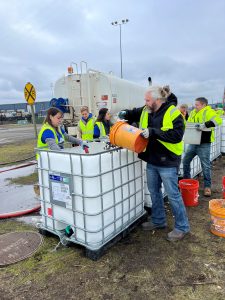Port Assists Estuary Partnership with Grattix Project

Volunteer workers pour in the base layer of rock for the Grattix boxes.
Rainwater is a key element in the Earth’s water cycle which is essential to life on Earth. But what happens when rain comes in contact with metal or shingled roofs before running off into the ground? Roof runoff can pick up contaminants from these roofs, including heavy metals used to discourage moss growth and then carry those contaminants to nearby waterways. In 2008, two talented port employees invented what is essentially a rain garden in a box to help purify roof runoff—and the results have been incredible. The Grattix (named for inventors Matt Graves and Mary Mattix) uses layered filtration materials and native plantings to remove unwanted contaminants in water runoff from roofs and downspouts. Although low-tech, low-cost, and low-maintenance, the Grattix system is extremely effective in lowering concentrations of heavy metals zinc (90-95%) and copper (85%) at project sites.
Part of the port’s mission is to educate others about the benefits and provide resources and support so other organizations can build their own Grattix boxes. Most recently, the port assisted the Lower Columbia Estuary Partnership (LCEP) as it applied for and received a $67,000 grant from the Environmental Protection Agency to build and deliver a number of Grattix boxes. LCEP volunteers, with guidance from port staff, built 20 Grattix boxes earlier this year for delivery to specific sites. The boxes are now being used at industrial businesses along the Columbia River from Scappoose, OR to Rainier, OR and on the Washington side of the river from Woodland to Longview, WA.
The port continues to be a source of information and support in stormwater treatment, making instructional materials readily available and partnering with various organizations in the pursuit of clean water.
